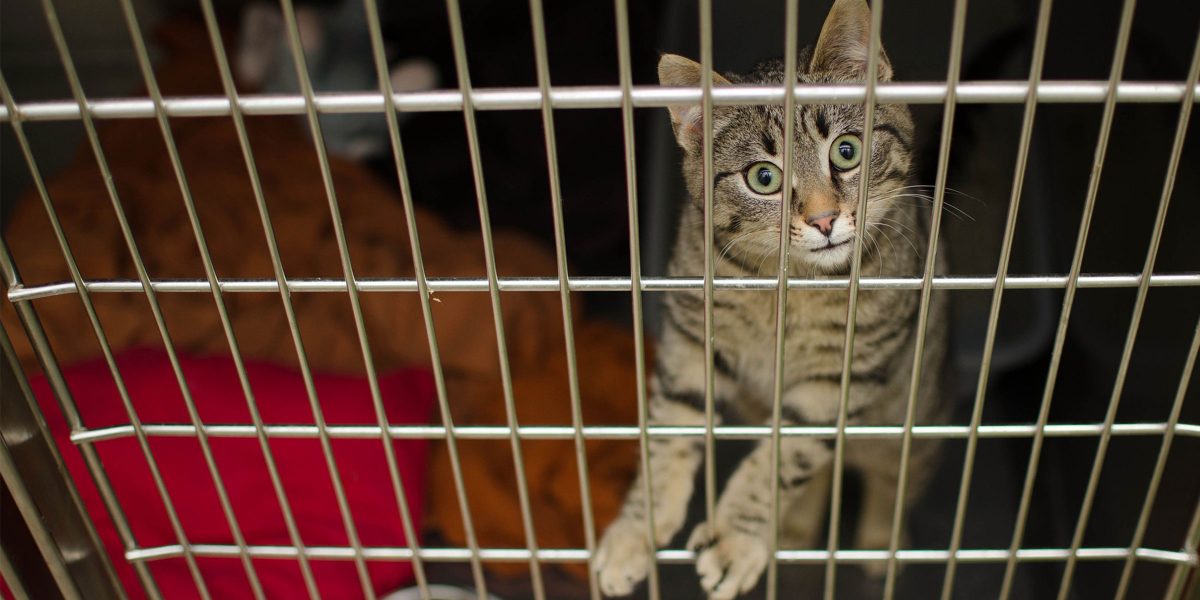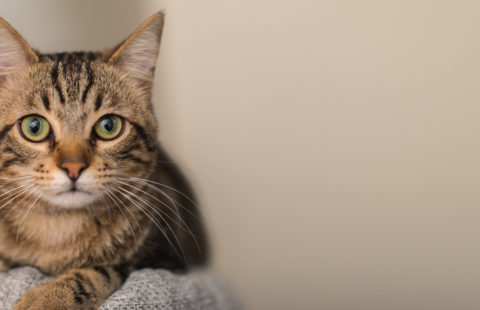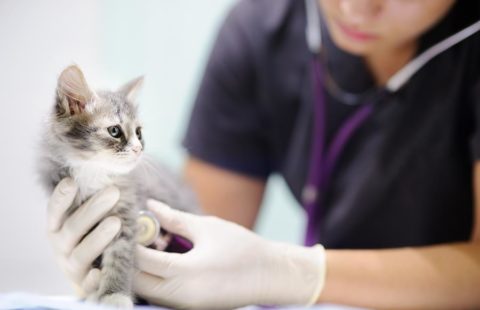iCatCare’s Elizabeth Waring talks us through the new study by Dr Stoneburner and colleagues on evaluating two types of front covers designed for hospital cages on their potential to reduce behavioural signs of stress in cats hospitalised in the veterinary clinic.
Being admitted or hospitalised at the veterinary clinic can be very distressing for cats. The length of time a cat has to stay in can vary, sometimes it is only for short periods of time, other times it may be an overnight stay or a period over several days and nights depending on the cat’s needs. During this time, cats will be exposed to a range of new sounds, sights, smells and experiences which could cause them to feel anxious, fearful and even frustrated. This may especially be an issue for cats that are hospitalised close to dogs or on busy wards where veterinary staff walk past frequently. Visual barriers are often used to help cats feel less exposed in their cages, including the use of towels over cage doors or creating hiding places within their cage, using cardboard boxes or cat carriers. A number of studies have previous investigated the efficacy of providing a hiding place in reducing behavioural signs of stress in cats in a range of confined settings including veterinary clinics, homing centres, laboratories and boarding catteries (eg, Kry and Casey, 2001, Vinke et al., 2014, Ellis et al., 2017, Rochlitz, 2000, Rehnberg et al., 2015, Van der Leij et al., 2019, Wright and Baugh, 2018). While hiding places offer the cat the opportunity to reduce its ability to see potential stressors, some believe these can make it difficult for staff to be able to visually monitor their patients during their stay.
Dr Stoneburner and colleagues from North Carolina State University in the USA investigated the efficacy of covering the front of the cage with either a clear or opaque plexiglass sheet (in comparison to no covering) on reducing behavioural signs of stress with the hypothesis that they may reduce visual and auditory stressors caused by a veterinary hospital environment.
How was the study set up?
The study design involved testing 30 pet cats in a simulated hospital environment rather than using a real veterinary hospital. This involved projecting a pre-recorded video of sights and sounds from a typical hospital ward to expose the cats to similar conditions to that of a real hospital setting during testing. Using a simulated set up as opposed to a real hospital setting has the advantage of enabling the experimenters to keep the conditions that the cats were exposed to standardised for each cat. This meant there were no variations in the levels of noise or light which could influence the cat’s behaviours or stress levels. However, the disadvantage of using a simulation is that it is not possible to know if the cats perceived, and subsequently responded to, this environment in the same way they would in a real hospital.
Two different interventions were assessed;
- a sheet of clear plexiglass to reduce noise for the cats
- a sheet of opaque plexiglass which reduced both sound and light.
Both of these options allowed the researchers to still visually see the cats whilst in their cages. During their time in the cage, the cat’s behaviour and body language were observed to identify the level of stress they were perceived to be experiencing, using Kessler and Turner’s Cat Stress-Scoring system (Kessler and Turner, 1997; Kessler and Turner, 1999). These scores were taken during the first and last 15 minutes of the cat being in the cage, after a 10-minute initial period to allow the cat to acclimatise to the cage set up. Cats were tested each day for 6 consecutive days and were given the choice of spending time in a cage with no alterations to the front (an ‘unshielded’ cage, with a metal grate like door) and a cage with either clear or opaque plexiglass attached to the front by offering. This was achieved by using two conjoined cages connected by a tunnel.
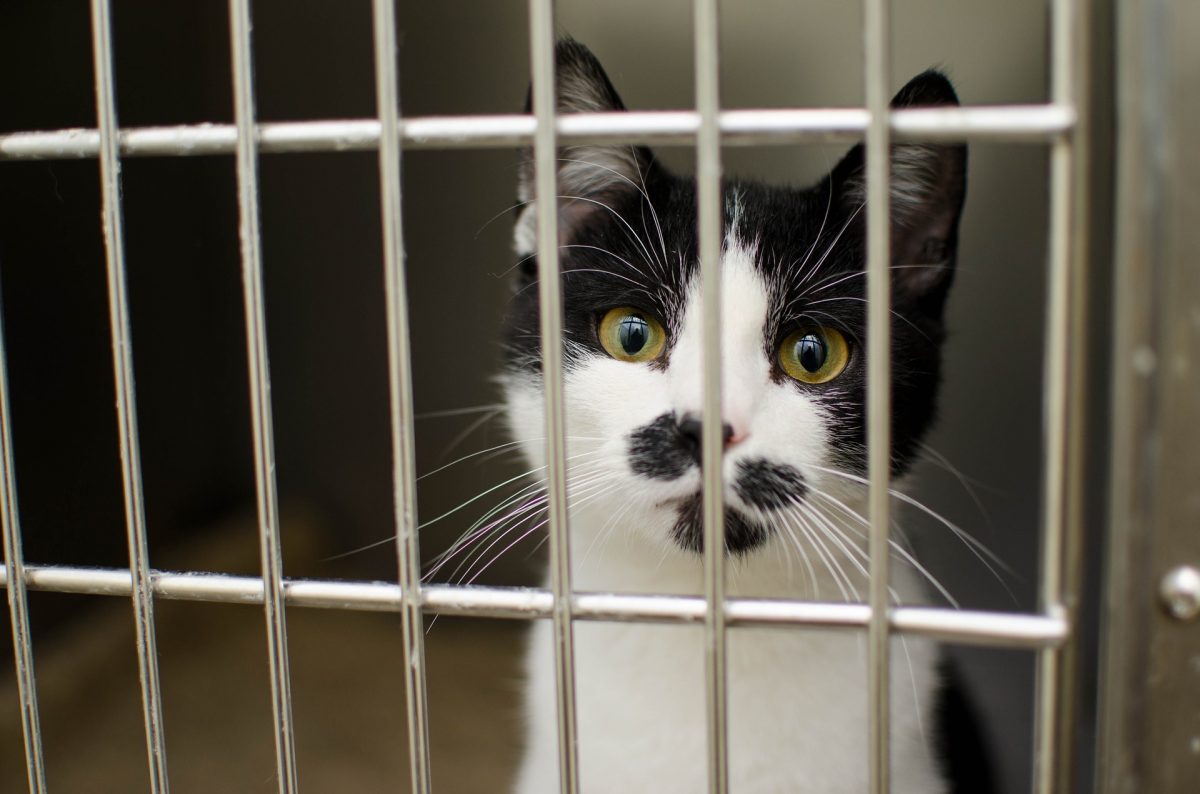
What were the key findings of this study?
- The level of stress the cat was experiencing directly influenced which cage the cat chose to spend time in. The more stressed the cats were observed to be at the beginning of testing, the more time the cats spent behind the cage front made of opaque plexiglass, which provided them with the most cover from external noise and light. If this option was not available, they chose to spend more time in the cage with the clear plexiglass, which still afforded them some cover from sounds. Both of these findings were in comparison to the time spent in the unshielded cage. Stress levels were based on behavioural assessment of the cat in the test cage using Kessler and Turner’s Cat Stress-Scoring system and conducted after an initial period of acclimatisation to the cage set up without the noise and visual projections. This minimised the impact of simply being placed in the cage environment on the cat’s stress scores recorded.
- Each cat was subjected to all three test conditions during testing and the cage conditions were randomly assigned over the six testing sessions. The cage side that the cat was initially placed in was randomly decided at the start of the study and was consistent across all six testing sessions. This meant that the cats were placed either into a shielded or unshielded cage to start with depending on the randomised cage configuration. The cats were freely able to choose which cage (shielded/unshielded) they wanted to spend time in during each session. However, the cats did show a slight preference for the right-hand side cage and the cage they were initially placed in, regardless of whether it was a shielded cage or not. During a few of the test sessions three cats remained in the cage they were initially placed in (two in the unshielded cage and one in the clear plexiglass cage) and showed no movement between the cages. This was particularly seen in cats with high stress scores. When feeling fearful, cats may remain motionless and freeze (as opposed to a ‘fight or flight’ response) and this likely accounts for a lack of movement by these cats.
- The study design did not allow for cats to have a choice of all three conditions at once during testing but this would have provided an interesting insight into the cats choice of either the clear or opaque plexiglass had they been initially placed into an unshielded cage and then given a simultaneous choice of the two covered conditions. This might have shown a clearer preference between the two options.
- Average stress scores declined over the 60-minute period that the cats were tested on all six test days, which indicated that the cats became adjusted to their surroundings with time regardless of which screen the cats were subjected to. Overall stress scores were also seen to decrease over the six consecutive testing days as the cats became more accustomed to the testing procedure.
- The authors concluded that whilst the level of light was significantly reduced by the opaque plexiglass (74.4% reduction) and the clear plexiglass (13.9% reduction), the noise levels were still relatively high with only a 4.5% reduction in noise behind the plexiglass screens (both opaque and clear) compared to the unshielded screen. Both noise and light levels were measured each day in the study cages prior to behavioural assessment. Therefore, using thicker plexiglass screens than those used in this study could potentially help to reduce noise levels further, whilst still being mindful to allow for ventilation. Although not specifically tested, it was also considered that the novel smells within the veterinary clinic might also be reduced when using plexiglass on the front of the cages, another potential stressor for cats who are very sensitive to smells within their environment.
- The finding that cats experiencing higher levels of stress preferred to spend time in cages which shielded them the most from the noise and sounds of the veterinary clinic, suggests that cats may find having reduced exposure to sound and light beneficial. This addition to their cage front may help them to better cope with being in the clinic environment, whilst enabling visual monitoring for staff so they can provide the cat with the best care during their stay.
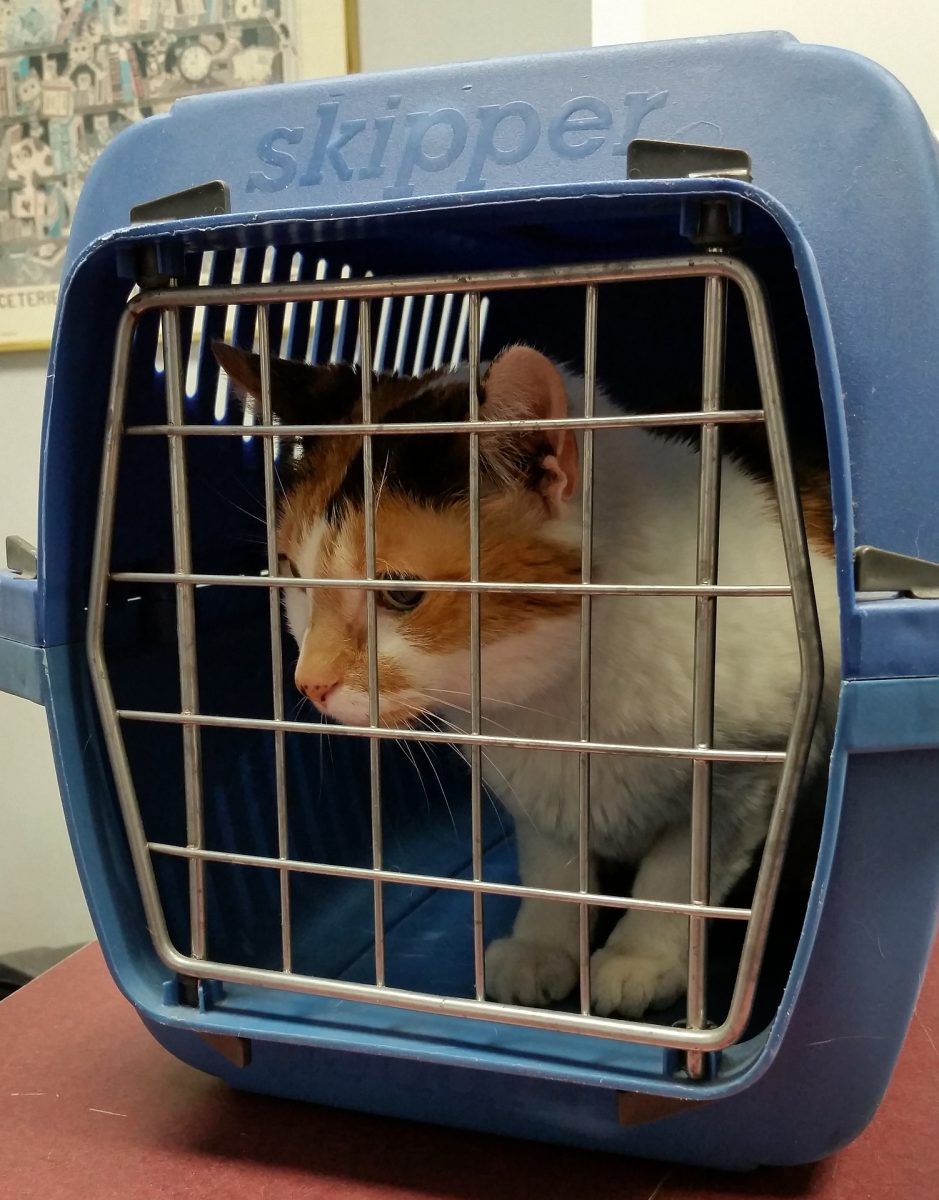
What is the potential impact of this research?
Stress can exacerbate existing (or promote the onset of) illness. Finding ways to reduce stress for cats being hospitalised is, therefore, hugely important both for the welfare of the cats but also to aid their recovery. The International Society of Feline Medicine (ISFM), the veterinary division of International Cat Care, created the Cat Friendly Clinic programme in 2012 and it now operates across the world. The aim of the programme is to address such issues by incorporating new ways of operating that result in reduced stress for cats (and their owners!) during their visit to a veterinary clinic. New research in this area is always useful for ensuring the best welfare standards are being incorporated into the recommendations the charity provides to veterinary professionals and owners, as well as potentially influencing how new equipment such as housing, is developed in the future.
Sarah Collins, ISFM Programme Director, gave us her thoughts on the research and how it provides evidence to support ISFM’s current recommendations to clinics accredited as Cat Friendly Clinics.
‘This study further emphasises our current knowledge on the importance of providing housing for cats in the hospital setting that meets their individual behavioural needs and for future developments on how we best provide this. As part of the ISFM Cat Friendly Clinic programme, all accredited clinics must provide each and every cat with the opportunity to hide within its cage to help manage stress levels and it is great to see further research in this area to improve our Cat Friendly knowledge.’
To find out more about the programme and find your local Cat Friendly Clinic, please visit the website: https://catfriendlyclinic.org
To read the paper in full please click here
References
Ellis, J. J, Stryhn, H, Spears, J and Cockram, M.S., 2017. Environmental enrichment choices of shelter cats. Behavioural Processes. 141; 1-6.
Kessler, M., Turner, D., 1997. Stress and adaptation of cats (Felis selvestris catus) housed singly, in pairs, and in groups in boarding catteries. Anim. Welf. 6, 243-254.
Kessler, M., Turner, D., 1999. Socialization and stress in cats (Felis selvestris catus) housed singly and in groups in animal shelters. Anim. Welf. 8, 15-26.
Kry, K., Casey, R., 2001. The effect of hiding enrichment on stress levels and behaviour of domestic cats (Felis sylvestris catus) in a shelter setting and the implications for adoption potential. Anim. Welf. 16, 375-383.
Rehnberg, L.K., Robert, K. A., Watson, S. J., Peters, R. A (2015) The effects of social interaction and environmental enrichment on the space use, behaviour and stress of owned housecats facing a novel environment. Appl. Anim. Sci. 169; 51-61.
Rochlitz, I., 2000. Recommendations for the housing and care of domestic cats in laboratories. Lab. Anim. 34, 1–9.
Vinke, C., Godijn, L., van der Leij, W., 2014. Will a hiding box provide stress reduction for shelter cats? Appl. Anim. Behav. Sci. 160, 86-93.
Wright, C and Baugh, S. 2018 Effectiveness of providing a box, or partially covering the cage front, on reducing cat stress. The Veterinary Nurse. 9; 328-332.



